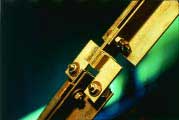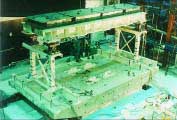Multidisciplinary Center for Earthquake Engineering Research (MCEER)
University at Buffalo
![]()
Engineering solutions for earthquake loss reduction
| A National Science Foundation Engineering Research Center since 1997 |
![]()
|
Core Partner Institutions:
|
Earthquakes don't kill people; collapsing structures do. Damage to such facilities impacts communities beyond immediate death and destruction, hindering their ability to cope and reclaim standards of life lost in the disaster. The United States has been fortunate to evade the large-scale destruction seen in other countries, but we are undoubtedly a nation at risk.
- According to the National Earthquake Hazards Reduction Program (NEHRP), no state is immune from earthquake hazards, and at least 44 are at risk of moderate or major seismic activity.
- With large concentrations of population, structures, and infrastructure in vulnerable urban centers across the U.S., the consequences from a damaging earthquake could be devastating.
- Economic losses from urban earthquakes are rising dramatically. Recent damaging U.S. quakes (Loma Prieta, 1989 and Northridge, 1994) recorded losses in tens of billions of dollars.
- Japan's 1995 Kobe earthquake, magnitude 6.9, resulted in economic losses exceeding $120 billion. A similar earthquake in a major U.S. metropolitan area could cause result in comparable losses.
Mission and Goals
The Multidisciplinary Center for Earthquake Engineering Research (MCEER), established in 1997, builds upon the base formed by the previous National Center for Earthquake Engineering Research, which was founded by the National Science Foundation in 1986. MCEER seeks solutions to reduce earthquake losses and help communities stand better prepared and increasingly resilient when faced with earthquakes. The center's mission is to discover, nurture, develop, promote, help implement, and in some cases pilot-test innovative measures and advanced and emerging technologies to reduce earthquake losses in a cost-effective manner.
Projects focus on use of technologies to strengthen critical facilities-hospitals, highways, and utilities-that communities depend upon in times of crisis, and to improve post-earthquake emergency response, crisis management, and recovery.
MCEER's nationwide program of research, education and outreach includes collaboration with business, industry, and government. Leading researchers from numerous disciplines and institutions throughout the U.S. integrate knowledge, expertise, and interdisciplinary perspective with state-of-the-art experimental and computational facilities in the fields of earthquake engineering and socioeconomic studies. The result is a systematic, "engineered" program of basic and applied research to reduce impacts of earthquakes.
Research
MCEER believes that the future of earthquake engineering lies in advanced and emerging technologies. Research includes innovative applications of engineered systems and materials, scientific methodologies, and concepts and analytical approaches not previously used in earthquake engineering and loss reduction.
Research teams investigate, adapt, and implement technologies to reduce earthquake hazards and provide a higher level of performance in buildings, infrastructure, and emergency response and recovery systems, than is possible with conventional techniques.
Advanced and emerging technologies being studied include but are not limited to:
- Site Remediation Technologies - to improve and stabilize soils and foundations
- Structural Control and Simulation - to protect buildings and bridges from damaging vibrations
- High-Performance Materials - to strengthen buildings, bridges, soils and pipelines
- Condition Assessment Technologies - to better estimate potential and actual earthquake losses
- Decision Support Systems - to enhance emergency response and post-earthquake recovery
Technologies are examined within four research programs-three funded by
the National Science Foundation (NSF), and a fourth involving Federal
Highway Administration (FHWA) contracts. A fifth thrust seeks to network
many of the nation's premier computational and experimental facilities
for advanced analytical, geotechnical, and structural earthquake engineering
studies. Programs are:
- Program 1 - Seismic Evaluation and Retrofit of Lifeline Networks (NSF)
- Program 2 - Seismic Retrofit of Hospitals (NSF)
- Program 3 - Emergency Response & Recovery (NSF)
- Program 4 - Seismic Performance and Reliability of the Nation's Highway System (FHWA)
- Program 5 - Facilities and Computational Networks in Earthquake Engineering (NSF)
Program 1 - Seismic Evaluation and Retrofit of Lifeline Networks.
MCEER collaborates with Memphis Light, Gas and Water (MLGW) and the Los Angeles Department of Water and Power (LADWP) to study real-world systems, scenarios, and strategies to retrofit existing water and power systems. The objective is to identify, explore, and develop advanced technologies to rehabilitate water supply and electrical power networks to ensure performance following earthquakes. The goal is to substantially improve the reliability of these networks and demonstrate this through the Los Angeles and Memphis systems.
Program 2 - Seismic Retrofit of Hospitals
Hospitals must remain operational after an earthquake to render emergency care. This may require retrofit of the building, its foundation, and its contents. While other critical buildings house important emergency services (i.e., fire, police, etc.), hospitals pose unique challenges, as they integrate complex structural and non-structural systems. Consequently, retrofit techniques developed for hospitals can be used to improve performance of less complicated critical facilities.
MCEER's hospital project involves a team with diverse expertise, including representation from the New York State and California health planning and development agencies, to account for differences in hospital construction, seismic environments, and societal concern for earthquake risk in the eastern and western United States.
Program 3 - Emergency Response and Recovery
Emergency response and recovery represent a community's final line of support following a damaging earthquake. In contrast to more "routine" emergencies, earthquakes can produce multiple emergencies that overwhelm authorities. Optimal response depends on quality advance planning and preparation.
The most significant challenge immediately following an earthquake is to accurately assess the situation and prioritize response needs. Advanced damage-detection methods are needed, and data must be incorporated into effective crisis-decision support systems. MCEER studies emphasize use of remote-sensing technologies for rapid damage assessment and loss estimation, and advanced decision support systems to ease and improve decision making in the immediate post-earthquake emergency period as well as during recovery and reconstruction.
Program 4 - Seismic Performance and Reliability of the Nation's Highway System
Improving seismic performance and reliability of the nation's highway system is the aim of MCEER's Highway Project. Initiated in 1992 with contracts from the Federal Highway Administration (FHWA), the project uniquely examines earthquake impacts on the highway system as an integrated network, rather than as a collection of individual roads, bridges, embankments, etc.
Projects seek to ensure usability of highways following earthquakes. Goals are to improve understanding of seismic hazards and improve and develop analysis methods, screening procedures and tools, retrofit technologies, design criteria, and methods to reduce vulnerability of existing and future highway infrastructure.
Program 5 - Facilities and Computational Networks in Earthquake Engineering
 |
| Seismic energy-absorbing dampers and materials are tested, developed and adapted by MCEER researchers for use in new construction and retrofit of existing structures. |
MCEER's consortium comprises state-of-the-art experimental and computational facilities from around the U.S. Remote access will link research teams, government and industry partners with laboratories for large-scale testing and computational needs. Combined facilities offer outstanding capabilities for study of seismic and geotechnical hazards, structural control and simulation, rehabilitation strategies for buildings and lifelines, and advanced technology and materials testing.
Education
MCEER's education initiatives provide learning opportunities for students and educators in K-12 through the university graduate level, and for practitioners seeking specialized continuing education.
 |
| Shake table tests enable MCEER researchers to examine and develop structural control and other advanced technologies to improve seismic performance of bridges, buildings and civil infrastructure. |
Programs include undergraduate internships, providing students with extensive involvement in ongoing research; a professional Master of Engineering program offering intensive graduate study in earthquake engineering and the current state-of-practice; and Professional and Continuing Education (PACE) short courses to help practitioners gain knowledge of advancements in research and application of emerging technologies in earthquake engineering and hazards mitigation.
Industrial Collaboration/Technology Transfer
MCEER forges strategic alliances with manufacturers, consultants, end-users and other public- and private-sector stakeholders to develop, adapt, test, and help implement use of new and emerging technologies to mitigate earthquake losses. The center's partnership program creates opportunities for cross-participation in research and demonstration projects, enabling partners to examine and assess reliability of technologies. It also provides partner access to research, education and technology transfer opportunities including state-of-the-art knowledge, experimental facilities, information resources, publications, seminars, short courses, and distance learning.
Center Configuration, Leadership and Team Structure
MCEER's director, Dr. George C. Lee, is supported and advised by senior staff and committees regarding center research, administration, and education and outreach initiatives. External Scientific Advisory (SAC) and Implementation Advisory Committees (IAC), and a Highway Seismic Research Council (HSRC) provide technical guidance.
Investigators in a number of key disciplines form interdisciplinary teams to accomplish objectives. These include seismologists, structural and geotechnical engineers, material scientists and engineers, risk and reliability engineers, and social, policy, and decision scientists.
![]()
Center Headquarters
Multidisciplinary Center for Earthquake Engineering Research
University at Buffalo
Red Jacket Quadrangle
Buffalo, New York 14261
Tel (716) 645-3391 · Fax: (716) 645-3399
E-mail: mceer@acsu.buffalo.edu
Homepage: mceer.buffalo.edu
MCEER Information Service
University at Buffalo
c/o Science and Engineering Library
304 Capen Hall
Buffalo, NY 14260-2200
Tel (716) 645-3377 · Fax (716) 645-3379
E-mail: mceeris@acsu.buffalo.edu
Center Director: Dr. George C. Lee
Extension 111 · gclee@acsu.buffalo.edu
Deputy Director: Dr. Michel Bruneau
Extension 104 · bruneau@acsu.buffalo.edu
Assistant Director, Education and Research Administration: Ms. Andrea
S. Dargush
Extension 106 · dargush@acsu.buffalo.edu
Industry Liaison Officer: Mr. Donald J. Goralski, APR
Extension 108 · goralski@acsu.buffalo.edu
NSF 00-137m